
by Contributed | Feb 10, 2021 | Technology
This article is contributed. See the original author and article here.
It is time once again to Reconnect, and this week we are thrilled to be joined by former Visual Studio and Development MVP Denis Kazakov!
Hailing from Kiev, Ukraine, Denis is a .NET software engineer whose areas of expertise include Xamarin, Azure, ASP.NET Core, and WP.
Denis is the founder and chief executive of FlatSolutions, a software development company with specialization in mobile, web and desktop applications using Microsoft technology stack. Since 2006, the company has delivered software development services for more than 60 clients from 20 countries around the world, including USA, United Kingdom, Australia, Germany, Brazil, India and more.
Recently, Denis has also been working on a free, non-commercial app to help people learn the basics of Microsoft Azure and Cloud Computing. The advertisement-free app, Learn Azure Fundamentals, teaches with 14 unique tests, 269 questions, and 132 articles. Moreover, Denis is already working on two additional teaching apps to instruct Azure for developers and help others prepare for Microsoft Certification exams.
“Then I have plans for a global education project to help people learn technologies based on their current background,” Denis says.
Looking back at his time as an MVP, Denis says he most enjoyed Azure Bootcamp in 2017 and the chance to meet all of the other Ukrainian MVP. He still manages to stay in touch with his local IT community as a regular contributor with Azure Ukraine and Belarus User Groups, as well as .NET Core user groups.
Reconnect offers an important opportunity to stay in touch with former MVPs, Denis says, with hopes to earn back his title once again in the future. To new MVPs, Denis recommends they: “contribute more — time is short!”
For more on Denis, check out his profiles on GitHub and StackOverflow.


by Contributed | Feb 10, 2021 | Technology
This article is contributed. See the original author and article here.
We have published another new class type this week. This class type shows how to set up a lab with ArcGIS Desktop’s ArcMap to make, edit, and analyze 2d geographic maps.
Like the other class types that we’ve published, this class is based on a real-world class that we partnered with a university to host using Azure Lab Services.
This class type includes the following information:
- Recommended VM size for the lab.
- How to setup ArcGIS, including the licensing server.
- Using OneDrive to backup files such as the mxd file, file geodatabases, etc.
- Recommended auto-shutdown setting values.
- Example costing for the class.
Here is where you can find the new ArcGISArcMap class type: Set up a lab for ArcMapArcGIS Desktop with Azure Lab Services – Azure Lab Services | Microsoft Docs
Thanks!
Azure Lab Services team

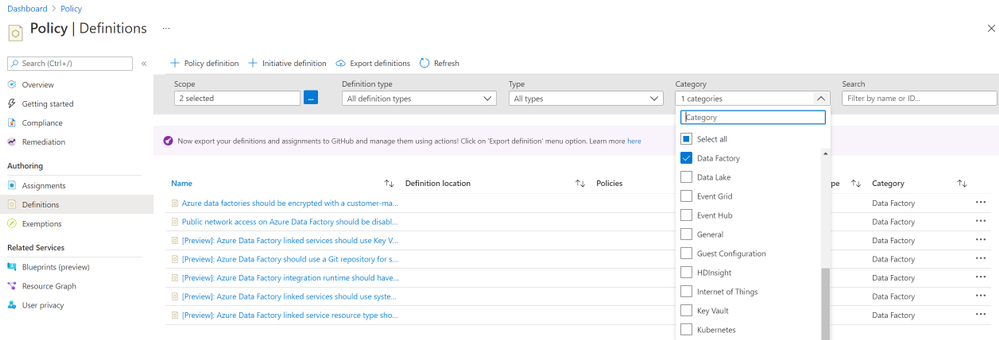
by Contributed | Feb 10, 2021 | Technology
This article is contributed. See the original author and article here.
We are very exited to announce that Data Factory Azure Policy integration is live now! There are several built-in policies that you can assign to your data factory to ensure resource consistency, regulatory compliance, and security.
Azure Policy is a service in Azure that enables you to create, assign, and manage policies that control or audit your resources. These policies enforce different rules and effects over your resource configurations so that those configurations stay compliant with corporate standards.
Create a policy assignment to Data Factory
1. Launch the **Azure Policy** service in the Azure portal.
2. Select **Definitions** on the left side of the Azure Policy page. Choose your subscription ID as **scope** and **Data Factory** as Category. Then you will see several built-in policies.
3. On the **Assign Policy** page, set the **Scope** by selecting the ellipsis and then selecting either a management group or subscription. Optionally, select a resource group. A scope determines what resources or grouping of resources the policy assignment gets enforced on. Then use the **Select** button at the bottom of the Scope page.

For more details about how to assign a policy, please see Create a policy assignment to identify non-compliant resources
Next steps
Learn about what is Azure Policy
Azure Policy built-in definitions for Data Factory
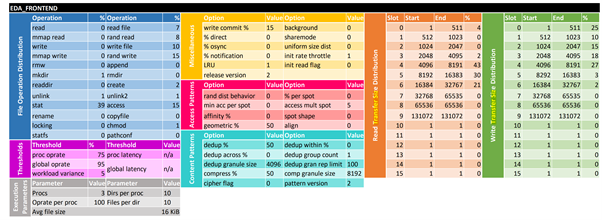
by Contributed | Feb 10, 2021 | Technology
This article is contributed. See the original author and article here.
Azure NetApp Files (ANF) was generally available on May 2019. Ever since it has been widely adopted across industries, including many silicon companies running their Electronic Design Automation (EDA) workloads on Azure. Azure NetApp Files provides 3 different tiers of service level to ensure throughput, NFS 3.0/NFS4.1/SMB mount protocols connecting from Windows or Linux VMs, and takes only minutes to setup. Enterprise can seamlessly migrate their applications to Azure with an on-premises-like experience and performance.
EDA workloads are generated by SPEC SFS® benchmark suite, to “measure file server throughput and response time.” The benchmark suite generates EDA operations on the ratio of EDA_FRONTEND and EDA_BACKEND as 3:2, to simulate a classic IC-design workload. The distribution of the operations are illustrated below:


(From SPEC SFS® 2014)
The goal of this article is to share lessons learned from running the SPEC SFS® EDA stress test on Azure NetApp files. Including:
- Provide practical performance best practices in real world.
- Examine ANF’s scale-out capabilities with multiple volumes.
- Compare ANF with other Azure file-based storage solutions including Azure Files NFS (preview) and Azure BLOB NFS (preview).
- Cost-effective analysis for users to choose the most suitable ANF’s tier of service level.
Architecture
The test was performed in Azure EAST US regions. Mix of Premium and Ultra tier with different sizes of volumes were tested. E64dsv4 or D64dsv4 VMs were acting as clients, which generated EDA workload operation, and reside in the same Proximity Placement Group with Accelerated Networking enabled.
The average ping latency from VMs to ANF was around 0.6~0.8 milliseconds.
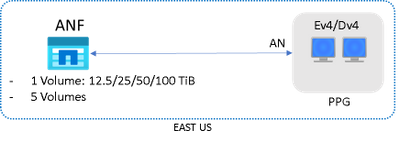
The overall performance is determined by two key metrics: Operations/sec and Response Time (millisecond). The test will incrementally generate EDA workload Operations, and Response Time will be recorded accordingly. The Operations/sec also indicates the combined read/write throughput (MB/s).
Performance Tuning
Below table shows the 8 different options have been examined and their performance impact. Please see Appendix for details and their applicability. If no specifically stated, NFS vers=3, mountproto=TCP, and default MTU=1500 were applied.
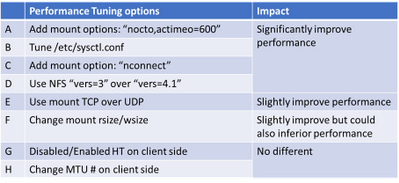
The below results shows that the first 3 (A, B & C) options can all improve response time and maximize throughput significantly, and the effectiveness can be added up.
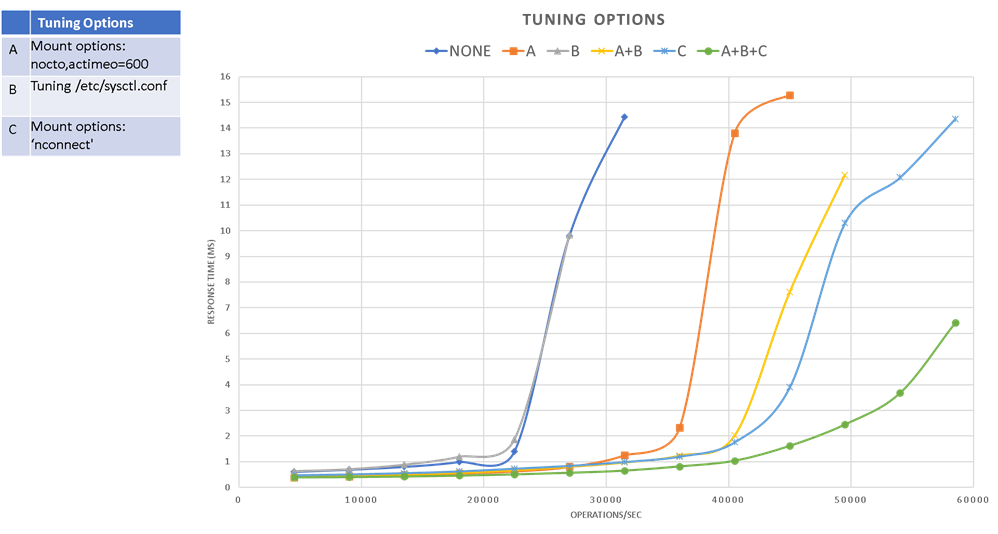
NFS 4.1 shows poor performance in this test compared to NFS 3. So be cautious of using it if there’s no specific security requirements.
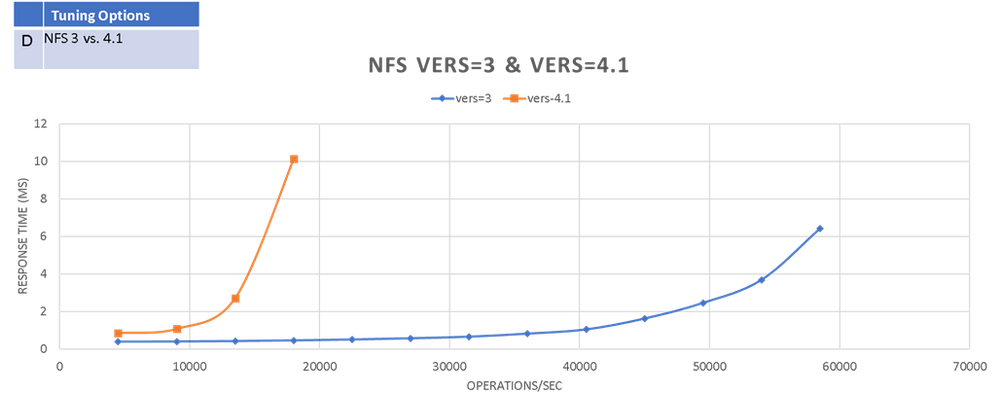
TCP shows slightly better performance than UDP (‘mountproto=udp’)
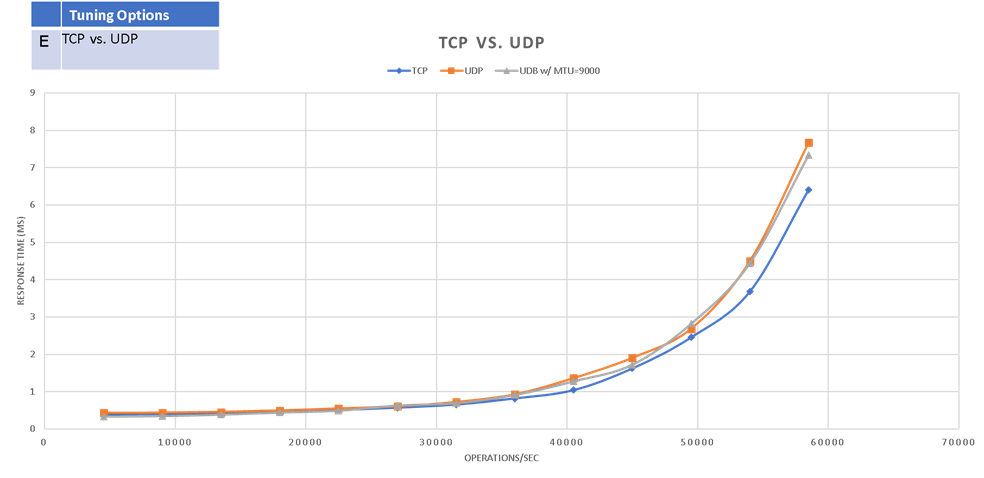
Appropriate rsize/wsize could improve performance. But be cautious to modify the default value (1MB/1MB) as unproper value could also inferior performance.

There’s no significant impact on performance when changing VM’s MTU # from default 1500 bytes to 9000 bytes.

Cost-Effective analysis
One advantage of ANF is it provides 3 tier of different service level with different pricing structure. That is, users are able to change the tier and volume size to reach the most cost-effective sweet spot when running their applications on Azure.
In below chart it shows:
- Premium 25TiB can achieve the same performance (max. throughput=58,500 ops/sec while maintaining same response time)
- Premium 12.5TiB can achieve max. throughput=54,000 ops/sec.
- Premium 6.25TiB can achieve max. throughput=27,000 ops/sec.
Which implies high IOPS EDA workloads (such as the LSF events share) can generally be done on the Premium tier and without excessively large volumes.

Scalability
- By simply adding # of volumes to ANF, max. throughput can scale linearly, and still maintaining low response time. (~500% from 1 to 5 volumes)
- In real world, EDA workloads are running on hundreds or thousands of nodes (VMs) connecting to the same ANF. Below chart shows more clients could further improve performance on either response time or overall throughput. As it surpasses the limitation of network bandwidth and max connections from one single VM.


Compare with Azure File NFS (preview) and Azure BLOB NFS (preview)
ANF shows superior performance than Azure Files NFS (preview) and Azure BLOB NFS (preview).
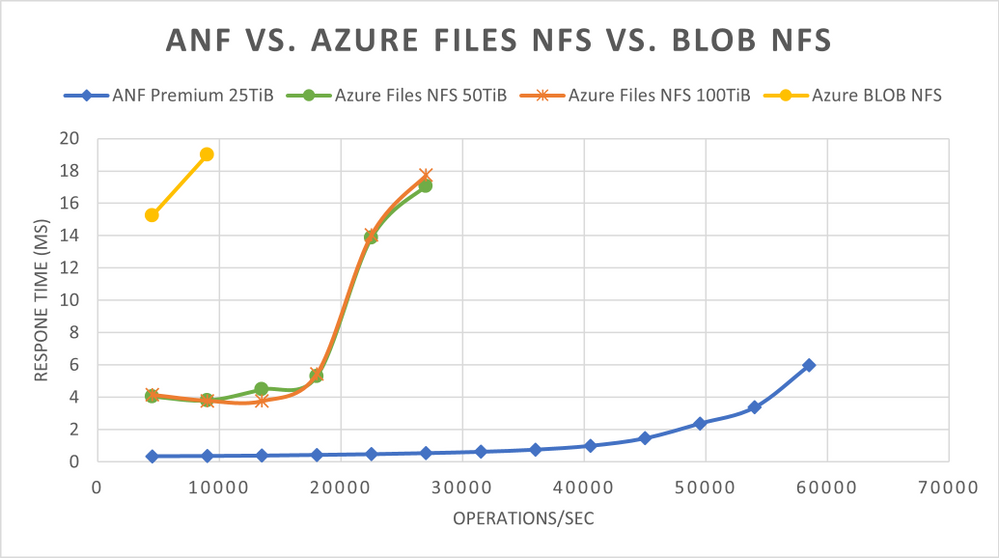
Summary
It’s important to keep in mind that in real-world, storage performance is impacted by a wide range of factors. This article is by no means to provide an ultimate guidance, but to share lessons learned from running the standard EDA benchmarking tools, and examine some generic performance best practice could be applied in your applications running on Azure.
Generally, the first 4 options (A, B, C & D) are suggested to be applied when applicable. As their effectiveness can be added up, they also improve Max. IOPS and bandwidth on regular FIO test:

And as stated please be cautious to change rsize/wsize (option F) as it could also impact performance in different way.
Appendix:
1. Tuning /etc/sysctl.conf (option B) example on Ev4/Dv4:
sudo vi /etc/sysctl.conf
Append or update the following attributes:
net.core.somaxconn = 65536
net.core.netdev_max_backlog = 300000
net.core.rmem_default = 67108864
net.core.wmem_default = 67108864
net.core.rmem_max = 67108864
net.core.wmem_max = 67108864
net.ipv4.tcp_rmem = 8192 87380 16777216
net.ipv4.tcp_wmem = 8192 87380 16777216
net.ipv4.tcp_fin_timeout = 5
To make the change effective:
sudo sysctl -p
2. Upgrade Linux kernel to 5.3+ to be able to utilize “nconnect” (option C). Please note that you will need to reboot the VM at the end of the upgrade. So it might not be applicable for some cases.
# CentOS/Redhat 7+
sudo rpm -Uvh http://www.elrepo.org/elrepo-release-7.0-2.el7.elrepo.noarch.rpm
# CenOS/Redhat 8+
sudo rpm --import https://www.elrepo.org/RPM-GPG-KEY-elrepo.org
sudo yum -y --enablerepo=elrepo-kernel install kernel-ml
sudo reboot
# check version:
uname -r

3. actimeo and nocto
The actimeo and nocto mount options are used primarily to increase raw performance. Please review NetApp ONTAP’s Best Practice Guide for applicability of your applications.
4. mounting examples:
TCP:
sudo mount -t nfs -o rw,nconnect=16,nocto,actimeo=600,hard,rsize=1048576,wsize=1048576,vers=3,tcp 10.1.x.x:/ultravol ultravol
UDP:
sudo mount -t nfs -o rw,nconnect=16,nocto,actimeo=600,hard,rsize=1048576,wsize=1048576,vers=3,mountproto=udp 10.1.x.x:/ultravol ultravol

by Contributed | Feb 10, 2021 | Technology
This article is contributed. See the original author and article here.

Hi IT Pros,
We still get the questions about Internet Explorer migration to Edge Chromium once in a while, especially from Government Agency Customers, the questions usually related to the in-house legacy application’ compatibility and develop tools.
Today we discuss about all thing migration from IE to Edge, I combine a check list of features, how to run Edge in IE compatible mode and the limitations for your review. We also touch on the new Edge feature Webview2 available in the near future.
Migrate from IE to Edge check list.
ActiveX control, Silverlight, Java
|
Microsoft Edge doesn’t support ActiveX controls or Browser Help Objects (BHOs) like Silverlight or Java. However, if you’re running web apps that use ActiveX controls, BHOs, or legacy document modes on Internet Explorer 11, you can configure them to run in IE mode on the new Microsoft Edge
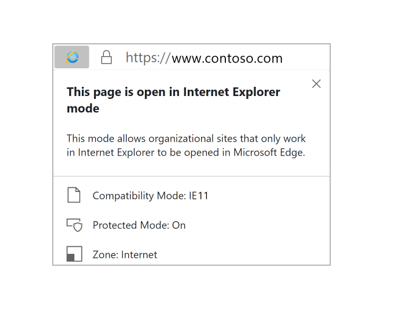 |
Edge browser in IE mode, features and configuration
|
Only those sites that you specifically configure (via policy) will use IE mode:
- List the site in the Enterprise Mode Site List XML defined in one of these policies:
- Microsoft Edge, “Configure the Enterprise Mode Site List”
- Internet Explorer, “Use the Enterprise Mode IE website list“
- The Microsoft Edge site list policy takes precedence over the Internet Explorer site list policy.
- All Intranet sites when the Send all intranet sites to Internet Explorer group policy is enabled.
IE mode supports the following Internet Explorer functionality
- All document modes and enterprise modes
- ActiveX controls (such as Java or Silverlight)
- Browser Helper Objects
- Internet Explorer settings and Group Policies that affect the security zone settings and Protected Mode
- The F12 developer tools for IE, when launch with IEChooser
- Microsoft Edge extensions (Extensions that interact with the IE page content directly are not supported.)
IE mode doesn’t support the following Internet Explorer functionality
- Internet Explorer toolbars
- Internet Explorer settings and Group Policies that affect the navigation menu (for example – search engines, and home pages.)
- IE11 or Microsoft Edge F12 developer tools
|
Use GPO to enable Edge Enterprise mode (IE compatible mode)
|
Computer configurationPoliciesAdministrative templateMicrosoft Edge
- Configure Internet Explorer integration
- Configure the Enterprise Mode Site List policy

|
Use GPO to enable IE Enterprise mode
|
Administrative TemplatesWindows ComponentsInternet ExplorerUse the Enterprise Mode IE website list

More info: Turn on Enterprise Mode and use a site list
(Internet Explorer 11 for IT Pros) – Internet Explorer | Microsoft Docs
Add multiple sites to the Enterprise Mode site list using a file and
the Enterprise Mode Site List Manager (schema v.2)
(Internet Explorer 11 for IT Pros) – Internet Explorer | Microsoft Docs
|
Edge feature to auto-redirect from IE to Edge if there is compatible function.
|
Many modern websites have designs that are incompatible with Internet Explorer (IE). When an IE user visits an incompatible public website, the user may get a message about incompatible browser. After the message, starting with version 84, automatically redirects users to Microsoft Edge.
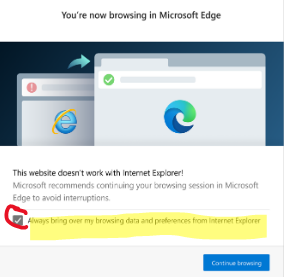
|
IE incompatible banner
|
- A website incompatibility banner is displayed under the address bar for each redirection.
- Users may continue to use IE for websites that are not on the IE compatibility list.
- Add / Remove Public site in compatible list : email suggestion to ietoedge@microsoft.com
|

|
Microsoft Edge supported browser privacy
with tracking prevention feature.
|
- The tracking prevention feature in Microsoft Edge protects users from online tracking by restricting the ability of trackers to access browser-based storage as well as the network.
- To configure, typing in the url address box: edge://settings/privacy.
- If any of the visited host names match with a host name on the Disconnect lists of Edge, Microsoft Edge proceeds with evaluating enforcement actions to prevent users from being tracked.
- You could set 3 level of prevention as shown here:
|
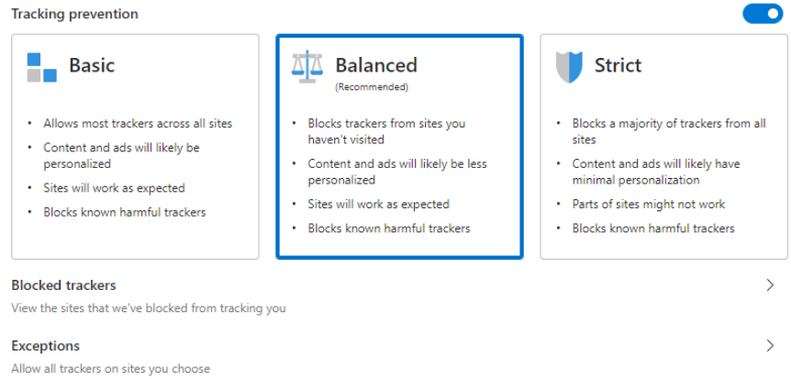
|
Unblock tracking prevention for company’s web developer.
|
Microsoft is currently working on the Storage Access API in the Chromium codebase. The Storage Access API gives site developers a way to request storage access from users directly, to quickly and intuitively unblock themselves.
|
|
Advertizing
|
Analytics
|
Content
|
Cryptomining
|
Fingerprinting
|
Social
|
Other
|
Same Org Mitigation
|
Org Engagement Mitigation
|
Basic
|
–
|
–
|
–
|
B
|
B
|
–
|
–
|
Enabled
|
N/A
|
Balanced
|
S
|
–
|
S
|
B
|
B
|
S
|
S
|
Enabled
|
Enabled
|
Strict
|
B
|
B
|
S
|
B
|
B
|
B
|
B
|
Enabled
|
Disabled
|
|
Same Org Mitigation
|
Microsoft Edge exempts a site from tracking prevention when the site is making third-party requests to other sites owned by the same parent organization (as defined in the Disconnect entities.json list)
|
Using Microsoft Edge DevTools to debug Office-Add-in
|
When the Office add-in is running in Microsoft Edge, you can use the Microsoft Edge DevTools.
- Run the add-in.
- Run the Microsoft Edge DevTools.
- In the tools, open the Local tab. Your add-in will be listed by its name.
- Click the add-in name to open it in the tools.
- Open the Debugger tab.
- Choose the folder icon above the script (left) pane. From the list of available files shown in the dropdown list, select the JavaScript file that you want to debug.
- To set a breakpoint, select the line. You will see a red dot to the left of the line and a corresponding line in the Call stack (bottom right) pane.
- Execute functions in the add-in as needed to trigger the breakpoint.
|
ClickOnce
DirectInvoke
|
Currently, Edge Chromium doesn’t provide native support for ClickOnce or DirectInvoke.
ClickOnce and DirectInvoke are features available in IE and Microsoft Edge classic (version 45 and earlier) that support the use of a file handler to download files from a website.
ClickOnce requests are handled by the native file handler in Windows. DirectInvoke requests are handled by a registered file handler specified by the website hosting the file.
ClickOnce and DirectInvoke in Microsoft Edge | Microsoft Docs
|
Edge Group Policy list:
Applies to Microsoft Edge version 77 or later (Edge Chromium).
Available Browser policies
To configure the group policy for a default file type and protocol associations configuration file:
- Open the Group Policy editor and go to the Computer ConfigurationAdministrative TemplatesWindows ComponentsFile Explorer.
- Select Set a default associations configuration file.
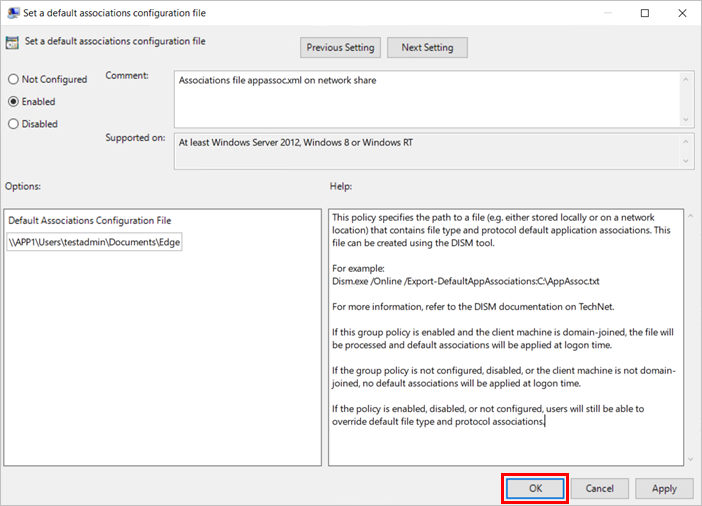
Import favorites in Microsoft Edge:
Open Microsoft Edge and select Settings and more at the top corner of the window.
Select Favorites > Import.
Under Import from, select the browser from which you want to import your favorites or select Favorites or bookmarks HTML file.
More Edge features and documents:
Reference:




Recent Comments